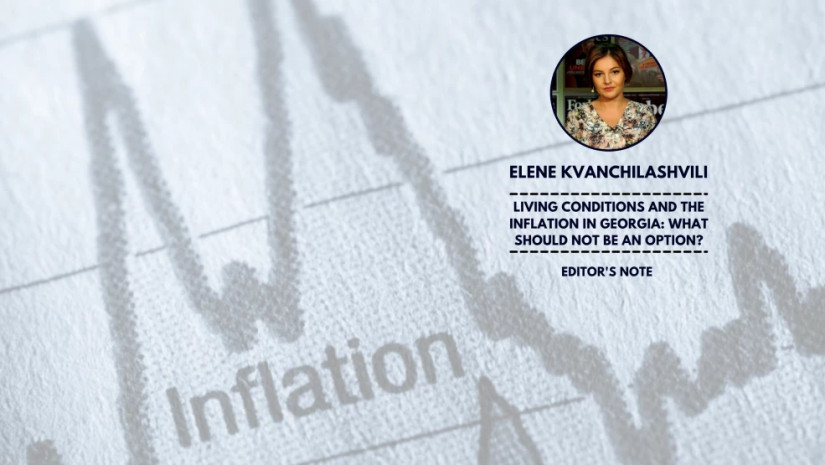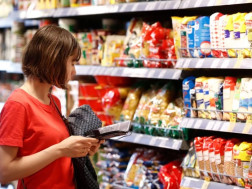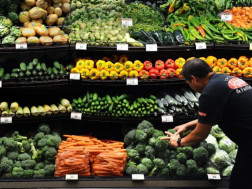As the accelerating spread of COVID-19 triggered the first global wave of lockdowns and social distancing measures last spring, it quickly became clear this would have a sweeping effect on the world not only from the public health but also from the economic standpoint. And so it is: COVID-19 has become both the synonym of economic crisis as well as a public health one.
In this Editor’s Note I will try to show you how the living conditions of Georgian citizens have changed during the pandemic and why it is important to curb inflation and keep it close to the target.
When we talk of living conditions we generally mean people at risk of poverty or social exclusion, income distribution, monetary poverty and material deprivation.
What we hear globally is that some 108 million more people have fallen into poverty or extreme poverty since 2019 (ILO).
Unfortunately, Georgia is no exception. According to the Absolute Poverty Statistics, there has not been a single year in the last decade when poverty has increased so dramatically.
Namely, during the pandemic 2020, poverty increased by 1.8 percentage points reaching 21.3% of the population or 794 thousand people, and making the population in regions even more exposed. Here the number of socially vulnerable population increased by 3.8 percentage points to 27.5%, while the absolute poverty in cities increased by 0.7 percentage points to 17.1%. In terms of gender, poverty increased more sharply by 2.1 percentage points among men and it stands at 21.7%. Among women, the increase in poverty was 1.5 percentage points up to 20.9%.
For those who managed to stay above the poverty threshold, during the pandemic 2020, the average monthly incomes decreased by 4.5% since 2019, amounting to about 1.2 million GEL. Average monthly incomes decreased by 6.4% per household, by 4.4% - per capita and amounted to 1100.5 GEL and 321.4 GEL respectively.
Again, the impact of pandemic is more severe on the population in regions. The amount of households' total incomes in urban areas decreased by 4.3% to 747.8 million GEL, while that of rural areas decreased by 5% to 446.9 million GEL.
The main source of incomes for households are cash incomes and transfers, which increased by 2.3 percentage points, year-on-year and reached 86.8%. Now, let us dissect the main drivers of this growth.
First, inflow volume of money transfers is up by 145.4% year-on-year. 94.9% percent of the total money transfers from abroad came from 18 largest partner countries, with the volume of transfers from these countries each exceeding 1 million USD in April 2021. In April 2020 the share of these 18 countries constituted 93% of the total volume of money transfers.
Second, the share of income from pensions, scholarships and social assistance increased by 4.4 percentage points compared to the same period of the last year and amounted to 23.4%. The most recent government report before the Parliament, covering the period from June 2020 to May 2021 says that 1.3 billion GEL is allocated for the social assistance provided to citizens under the anti-crisis plan, 0.9 million GEL for healthcare and quarantine measures, 2.2 billion GEL for business and economic growth measures (big portion of all this being a debt) and the total impact of this assistance on the state budget will be 4.4 billion GEL.
To come back to the income structure during the pandemic 2020 though, we can clearly see that the income from wages has a significant contribution in the structure of cash incomes and transfers, the share of which decreased by 0.9 percentage points, year-on-year and amounted to 47.8%. Additionally, the share of income from self-employment decreased by 2 percentage points and equaled 9.4%.
The reasons for this are to be found in the employment numbers during the pandemic. The pandemic 2020 closed with 20.4% unemployment rate, up from 16.6% in 2019. Both economic activity rate and employment rate have fallen. The impact was bigger on hired employees, while self-employment increased slightly by the end of the pandemic 2020. The largest share of the self-employed are mainly subsistence farmers.
We often hear that the economic crisis face of the COVID-19 is so dramatic, because the pandemic affects not only the supply side but the demand side as well. In 2020, the average monthly expenditures of the population in Georgia decreased by 7.6% since 2019, amounting to about 1.1 million GEL. The average monthly expenditures per household decreased by 9.4% to 1.03 million GEL, while the average monthly expenditures per capita decreased by 7.4% to 303.3 GEL.
The decrease was higher in rural areas: The amount of households’ expenditures in urban areas decreased by 6.5% to 714.4 million GEL, while for rural areas it decreased by 9.4% to 412.9 million GEL.
What figures also tell us is that the share of household cash consumption expenditures in total expenditures increased by 2 percentage points compared to 2019, up to 70.1%. Expenditures on food, beverages, tobacco has a significant share in the structure of the cash consumption expenditures, amounting to 42.1%.
And that’s where we come to the second part of this Note – namely, why inflation matters so much. As of May 2021, the annual inflation rate stands at 7.7%, which is quite far away from the target of 3% as stated by the Central Bank of Georgia.
The annual inflation rate was mainly influenced by price changes for the following groups: Transport prices up by 17.4%; Health prices up by 13.4%; Housing, water, electricity, gas and other fuel prices up by 6.6%; and Food and non-alcoholic beverages up by 3.3%. Almost everything that dominates in household expenditures is more expensive today.
That’s where the main chain reaction must be taken into consideration.
Even though Georgia has a floating exchange rate and neither government nor the Central Bank want to take any responsibility on how the national currency behaves in this country, the stubborn fact is that Lari depreciation has a very strong spill-over effect on prices, since Georgia is still an import-depended country.
After the record 44.8% economic growth in April 2021- which we have analyzed together before – Lari has the strengthening trajectory against US dollar. The national currency has strengthened by 25 tetri for the last 30 days. If this trend is maintained then importers and distributors assure us that we should expect lower prices on most of goods from September.
The only way for Lari to stay strong is to open the economy. With easing the restrictions, including the opening of land borders, in this moment of time, private sector seems to have improved expectations which considering the structure of Georgia’s economy, has quite a weight on forming the exchange rate.
However, the pandemic hasn’t yet gone anywhere which means that opening borders without the sufficient pace of vaccination, might end up as a booster of another epidemiological wave and a strong reason to lockdown, again.
More so, the labor market crisis created by the COVID-19 pandemic is far from over, and employment growth will be insufficient to make up for the losses suffered until at least 2023, according to a new assessment by the International Labor Organization (ILO).
If we look at the first quarter of 2021, we clearly see that the tendency of rising unemployment is still in place: In the first quarter of 2021 the unemployment rate in Georgia increased by 3.7 percentage points compared to the same period of 2019, reaching 21.9%.
There is no doubt that without mass-vaccination in place these figures will continue to grow.
The government administration says that more than 3.6 million doses of vaccine will be mobilized in Georgia late this year, and that active preparations for massive roll out of COVID-jabs are already underway.
The Ministry of Health has one week to develop a plan for mass-vaccination sites, which will be submitted to the Coordinating Council for approval. Meanwhile, the National Center for Disease Control and Public Health (NCDC) will train additional brigades and rural doctors to be involved in this process.
Deputy Minister of Health has also assured us that massive vaccination will allow the country to vaccinate 18% of the adult population by the end of September, and that expectations that massive roll out of COVID-jabs will start in the near future, are real.
So it seems, the coming months could prove crucial. One concern is that Lari strengthening expectations, by businesses and consumers alike, cannot be taken for granted – as of June 7, Lari has devaluated against US dollar by 7.78 tetris. With the latest consistent trend of Lari devaluation, businesses and consumers are cautious that the current trend of strengthening could be sustained. Such behavioral changes can morph into a vicious cycle, with businesses and consumers stockpiling more USD before they need them. That would only reinforce depreciation and respectively, inflationary pressures, and lead to an even stricter monetary policy decisions, hampering economic growth, prolonging Janus-faced pandemic and worsening living conditions of Georgian citizens further.
This should not be an option!
















